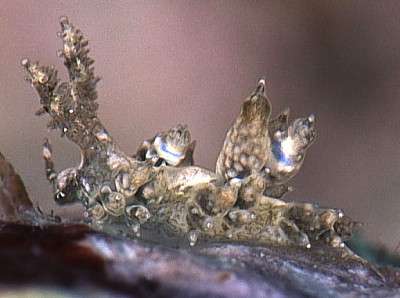
Baeolidia japonica
Baba, 1933
Order: NUDIBRANCHIA
Suborder: AEOLIDINA
Family: Eubranchidae
DISTRIBUTION
Japan
PHOTO
This species is very rare in Kerama Is. [near Okinawa], in Japan. I saw only one individual at bottom of a bay in May, 1999. 7mm long alive. PHOTO: Atsushi Ono.
I initially suggested this may be a species of eubranchid, mainly because of the shape of the cerata. See Atsushi Ono's message below. However I now think it may be Baeolidia japonica. See my comments below.
References:
• Baba, K. (1933) Supplementary note on the Nudibranchia collected in the vicinity of the Amakusa Marine Biological Laboratory. Annotationes Zoologicae Japonenses, Tokyo, 14(2): 273-283.
• Baba, K (1949) Opisthobranchia of Sagami Bay collected by His Majesty The Emperor of Japan. Iwanami Shoten, Tokyo. 194pp., 50 Pls.
Rudman, W.B., 1999 (December 23) Baeolidia japonica Baba, 1933. [In] Sea Slug Forum. Australian Museum, Sydney. Available from http://www.seaslugforum.net/find/bergjapo
Related messages
Baeolidia sp. from sthn Queensland
November 27, 2009
From: Gary Cobb
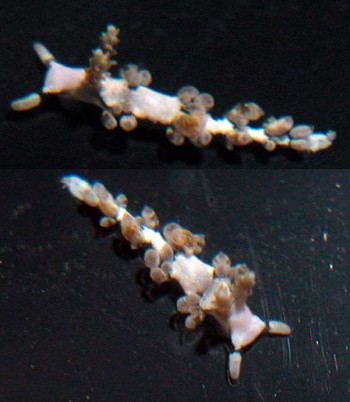
Concerning message #7665:
Hi Bill and everyone!
Please find Baeolidia sp. found here in sthn Queensland. In situ this animal was spotted after 8 minutes of diving. It is our 396th species.
Note the opaque white "frosting" on it's topside. The huge rhinophores are very "antler" style with papillae all the way around. Also note the oral tentacles are very short and rounded.
Locality: Inner Gneerings, Mooloolaba, 18 m depth, Queensland, Australia, Pacific Ocean, 30 October 2009, Subtidal. Length: 4 mm. Photographer: Gary Cobb and David Mullins.
When this species travels it raises it's head and turns side to side at the same time!
Cheers
Gary
gary@nudibranch.com.au
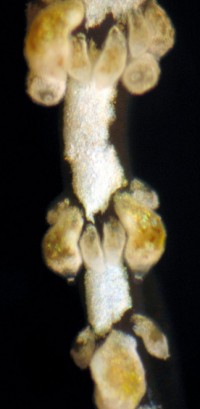
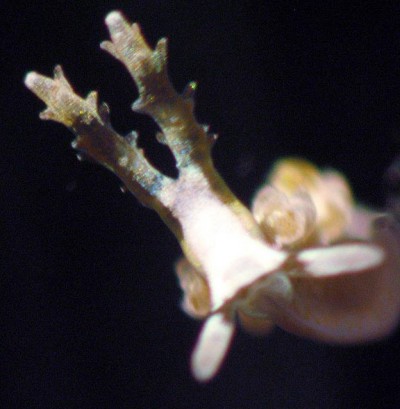
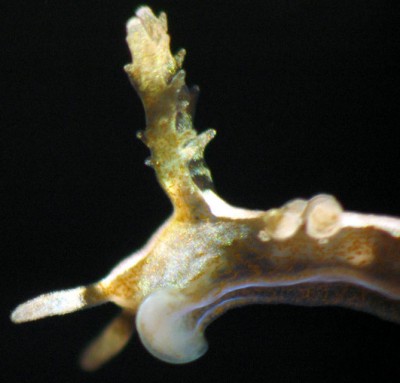
Dear Gary,
It's hard to know whether this small animals has much growing to do or not. Apart from the large rhinophores, most of the rest of the body and cerata seem to be in proportion. It could well be Baeolidia japonica. We know so little about that species we can't really say how much variability it shows.
Best wishes,
Bill Rudman
Re: Baeolidia japonica from Japan.
August 10, 2002
From: Jun Imamoto
Dear Bill.
Thank you for your comment. I agree to your opinion. This sea slug has now been found many times in the same place. With reports from my friends, Mr. Kurihara and Ms. Yamada, we now know of more than the total 20 individual, too. From now on, the reports of this sea slug from Japan may increase.
Best Regards,
Jun Imamoto
http://umiushi.zive.net/
imamoto@wips.co.jp
Imamoto, J., 2002 (Aug 10) Re: Baeolidia japonica from Japan.. [Message in] Sea Slug Forum. Australian Museum, Sydney. Available from http://www.seaslugforum.net/find/7746Baeolidia japonica from Japan.
August 9, 2002
From: Jun Imamoto
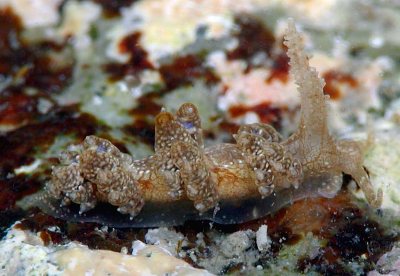
Dear Bill.
I found this sea slug which looked like Berghia japonica. We found it after seeing in Opisthobranchia of Sagami Bay by Kikutaro Baba, that it had been found in very shallow water. We thought that we couldn't find it by Scuba-Diving, so my wife and I looked in very shallow water and my wife found a pair of these sea slugs under a stone. So we think it is probably not uncommon at this place. I would be very happy if I could hear your comment.
date: 27 July 2002
place: Osezaki, Izu Peninsula, Suruga bay, Japan
size about: 10mm
depth: 2m
temperature: 26 C
Best Regards,
Jun Imamoto
http://umiushi.zive.net/
imamoto@wips.co.jp
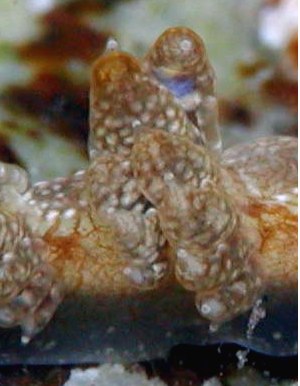

Dear Jun,
Another interesting find as there seem to be very few records of this species. Your photo certainly looks more like the painting in Baba (1949) than Atsushi Ono's photos from Kerama Id. which I first thought were a species of Limenandra. The blue markings on the inside of the cerata in both yours and his photos show that his animals are almost certainly B. japonica as well. The brown network, presumably ducts of the digestive gland can be clearly seen on the sides of the body and the head. This suggests that the species may also be solar powered, storing, or keeping alive, zooxanthellae in its tissues.
One problem is what genus this species should be placed in. Baba described it as Baeolidia japonica, and it is has been transferred to Spurilla and Berghia at various times since then. If we follow Miller's (2001) recent review of the family, the most appropriate place seems to be back in Baeolidia.
• Miller, M.C. (2001) Aeolid nudibranchs (Gastropoda: Opisthobranchia) of the family Aeolidiidae from New Zealand waters. Journal of Natural History, 35: 629-662.
Best wishes,
Bill Rudman
Berghia japonica? from Kerama Is
December 23, 1999
From: Atsushi Ono
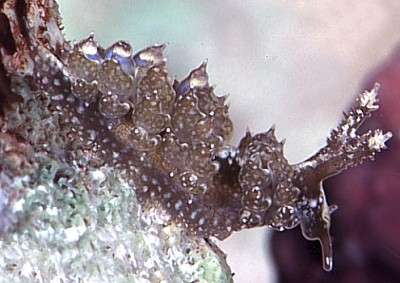
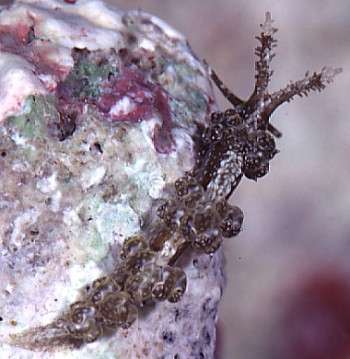
Dear Bill,
The other day I found another specimen of the species you are calling "Eubranchus sp. 1".
This is maybe adult individual. 7m depth, 15mm long. at Kerama Is. Is this Limenandra sp. 1?
Sincerely,
Atsushi Ono
ononini@cosmos.ne.jp
Ono, A., 1999 (Dec 23) Berghia japonica? from Kerama Is. [Message in] Sea Slug Forum. Australian Museum, Sydney. Available from http://www.seaslugforum.net/find/1697Dear Atsushi,
These photos make it pretty clear that it is not a species of Eubranchus. The cerata are a lot more flattened than it appeared in the earlier photos. I think it belongs in the Family Aeolidiidae but I don't think it is Limenandra sp. 1.
One strong possibility would be Baeolidia japonica Baba 1933 [Berghia japonica].
It is described as being relatively small (18mm long maximum), brown with white spots, papillate rhinophores and somewhat flattened cerata. There is no mention in the descriptions of the blue band on the inside of the cerata.
I can find few references to this species other than the original description from Tomioka Bay (Baba, 1933), Sagami Bay (Baba, 1949) and Toyama Bay (1964).
Any comments on this suggested identifcation are welcome.
Best wishes,
Bill Rudman.
Re: Limenandra nodosa? from Kerama Is
August 19, 1999
From: Atsushi Ono
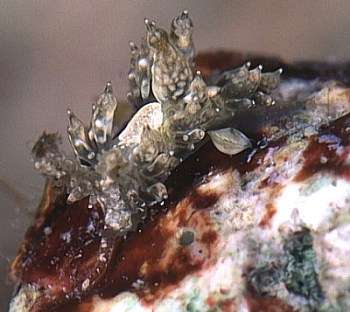
Dear Bill,
Thank you for your suggestion that this might be a juvenile Limenandra nodosa. A species that I intended to send you a photo next time was Limenandra nodosa!
I have photographed several individuals of L. nodosa (10-15mm long). But I'm afraid I can't see this species as L. nodosa by form and color of its cerata, and the white patch on its nose....
I have enclosed another photo of this small aeolid. It has two big white patches on its back without pink ring. To my regret,I didn't take a photograph of dorsal view of this animal.
I can't write well my idea in English, I'm sorry.
Sincerely,
Atsushi Ono
ononini@cosmos.ne.jp
Ono, A., 1999 (Aug 19) Re: Limenandra nodosa? from Kerama Is. [Message in] Sea Slug Forum. Australian Museum, Sydney. Available from http://www.seaslugforum.net/find/1213Dear Atsushi,
Your English is a lot better than my Japanese! Thanks for the second photo of this puzzling little aeolid. I'm afraid I thought from your first photo that the cerata were papillate, but now I see that what I thought were retracted papillae are just whitish patches.
My next guess is that it is possibly a species of Eubranchus, or a related genus, but I don't know any species of Eubranchus with papillate rhinophores as in this species. I agree that my suggestion that it was possibly Limenandra nodosa is clearly wrong, but I can't make a better guess without some anatomical information.
Thanks also for the photos of real Limenandra nodosa and possibly a second species of Limenandrawhich I have posted separately.
Best wishes.
Bill Rudman.
Limenandra nodosa? from Kerama Island
August 13, 1999
From: Atsushi Ono
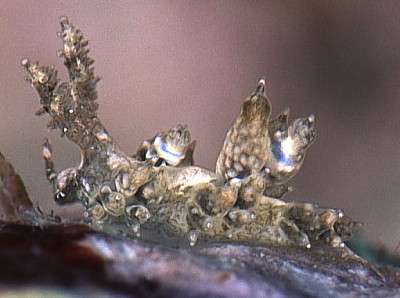
Dear Bill,
I would like to thank Clay & Patty Jo for haminoeid species ID.
The other day, I found fascinating aeolid. It has a gray-brown body color. Its bigger cerata has a semicircle blue band. Rhinophores are papillate? 7mm long. This species very rare in Kerama Is. [near Okinawa], in Japan.I saw only one individual at bottom of a bay in May.
Could you help me to identify this aeolid?
Sincerely,
Atsushi Ono
ononini@cosmos.ne.jp
Ono, A., 1999 (Aug 13) Limenandra nodosa? from Kerama Island. [Message in] Sea Slug Forum. Australian Museum, Sydney. Available from http://www.seaslugforum.net/find/1180Dear Atsushi,
I think it is Limenandra nodosa. The shape of the rhinophores and the papillate cerata are very similar, and the cerata seem to be arranged in double rows.
Your photo doesn't show the characteristic concentric rings on the dorsum, but they can be absent. I haven't seen a specimen with the blue and yellow markings that your animal has on the inside of the large cerata, but that could be a local variation .... or I could be quite wrong!
If it is Limenandra, your animal is either a juvenile or else it has been damaged (had part of its body bitten off?) and is regrowing.
Best wishes,
Bill Rudman.
